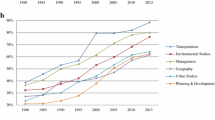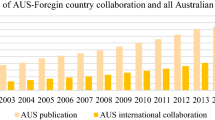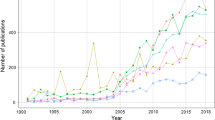Abstract
We trace the structural patterns of co-authorship between Korean researchers at three institutional types (university, government, and industry) and their international partners in terms of the mutual information generated in these relations. Data were collected from the Web of Science during the period 1968–2009. The traditional Triple-Helix indicator was modified to measure the evolving network of co-authorship relations. The results show that international co-authorship relations have varied considerably over time and with changes in government policies, but most relations have become stable since the early 2000s. In other words, the national publication system of Korea has gained some synergy from R&D internationalization during the 1990s, but the development seems to stagnate particularly at the national level: whereas both university and industrial collaborations are internationalized, the cross-connection within Korea has steadily eroded.






Similar content being viewed by others
References
Abramo, G., D’Angelo, C. A., & Pugini, F. (2007). The measurement of Italian universities’ research productivity by a non parametric-bibliometric methodology. Scientometrics, 76, 225–244.
Abramson, N. (1963). Information theory and coding. New York: McGraw-Hill.
Adams, S. J. D., Black, G. C., Clemmons, J. R., Paula, E., & Stephan, P. E. (2005). Scientific teams and institutional collaborations: Evidence from U.S. universities, 1981–1999. Research Policy, 34(3), 259–285.
Albuquerque, E. M. (2001). Scientific infrastructure and catching-up process: Notes about a relationship illustrated by science and technology statistics. Revista Brasileira de Economia, 55(4), 545–566.
Altbach, P. (2007). Empires of knowledge and development. In P. Altbach & J. Balán (Eds.), World class worldwide: Transforming research universities in Asia and Latin America. Baltimore: The Johns Hopkins University Press.
Bak, H. J. (2006). Characteristics and transformation of Korean academic science: Focusing on the trend of academic R&D expenditure since 1980s. Social Theory, 30, 213–244.
Bordons, M., Gómez, I., Fernández, M. T., Zulueta, M. A., & Méndez, A. (1996). Local, domestic and international scientific collaboration in biomedical research. Scientometrics, 37(2), 279–295.
Braun, T., & Glänzel, W. (1996). International collaboration: Will it be keeping alive East European Research? Scientometrics, 36(2), 247–254.
Chung, S. (2005). Catch up through international linkage, science, technology and the Korean experience. Science and Public Policy, 29(6), 431–437.
Chung, S. H., & Seol, S. S. (2010). Stages and drivers for the development of basic scientific research in Korea. Korean Journal of Technology Innovation Society, 13(3), 587–616.
Etzkowitz, H., & Leydesdorff, L. (2000). The dynamics of innovation: From national systems and mode 2 to a triple helix of university–industry–government relations. Research Policy, 29(22), 109–123.
Georghiou, L. (1998). Global cooperation in research. Research Policy, 27(6), 611–626.
Glänzel, W. (2001). National characteristics in international scientific co-authorship relations. Scientometrics, 51, 69–115.
Glänzel, W., & Schubert, A. (2010). Analysing scientific networks through co-authorship, Chapter 11. In Moed, et al. (Eds.), Handbook of quantitative science and technology research (pp. 257–276). Dordrecht: Kluwer.
Godin, B., & Gingras, Y. (2000). The place of universities in the system of knowledge production. Research Policy, 29(2), 273–278.
Gómez, I., Bordons, M., Fernández, M. T., & Morillo, F. (2009). Structure and research performance of Spanish universities. Scientometrics, 79(1), 131–146.
Gordon, M. D. (1980). A critical reassessment of inferred relations between multiple authorship, scientific collaboration, the production of papers and their acceptance for publications. Scientometrics, 2, 193–201.
He, Z. L. (2009). International collaboration does not have greater epistemic authority. Journal of the American Society for Information Science and Technology, 60(10), 2151–2164.
Hwang, K. (2007). International collaboration in multilayered center-periphery in the globalization of science and technology. Science Technology Human Values, 33, 101–133.
Jakulin, A., & Bratko, I. (2004). Quantifying and visualizing attribute interactions: An approach based on entropy. Retrieved May 23, 2008, from http://arxiv.org/abs/cs.AI/0308002.
Katz, J. S., & Hicks, D. M. (1996). A systemic view of British Science. Scientometrics, 35, 133–154.
Katz, J. S., & Hicks, D. (1997). How much is a collaboration worth? A calibrated bibliometric model. Scientometrics, 40(3), 541–554.
Katz, J. S., & Martin, B. R. (1997). What is research collaboration? Research Policy, 26, 1–18.
KICOS. (2008). Statistics on International R&D Program. Seoul: Korea Foundation for International Cooperation of Science and Technology.
Kim, L. (1997). Imitation to innovation: The dynamics of Korea’s technological learning. Boston, MA: Harvard Business School Press.
Kim, M. J. (2005). Korean science and international collaboration, 1995–2000. Scientometrics, 63(2), 321–339.
Kim, Y. J., Yeo, M. S., & Oh, D. (2010). Measuring the quality of research performance by relative rank-normalized impact factor (R2nIF). Asian Research Policy, 1, 27–42.
Krippendorff, K. (2009). Information of interactions in complex systems. International Journal of General Systems, 38(6), 669–680.
Kwon, K. S. (2009, Feb 27). Emergence of research and entrepreneurial activities of Korean universities. Paper presented at the conference on university-industry linkages and economic performance, College of Social Science, Seoul National University.
Laudel, G. (2002). What do we measure by co-authorships? Research Evaluation, 11(1), 3–15.
Lee, S., & Bozeman, B. (2005). The impact of research collaboration on scientific productivity. Social Studies of Science, 35(5), 673–702.
Lee, M., Kim, K., Choi, Y., Song, C., & Kim, E. (2008). Exploratory study on the international S&T cooperation with developing countries. Washington, DC: Science and Technology Policy Institute.
Lemarchand, G. A. (2010). The long-term dynamics of co-authorship scientific networks. Iberoamerican Countries (1973–2006). arXiv:1001.2837v1.
Lengyel, B., & Leydesdorff, L. (2011). Regional innovation systems in Hungary: The failing synergy at the national level. Regional Studies, 45(5), 677–693.
Leydesdorff, L. (2010). Redundancy in systems which entertain a model of themselves: Interaction information and the self-organization of anticipation. Entropy, 12(1), 63–79. doi:10.3390/e12010063.
Leydesdorff, L., & Rafols, I. (2011). How do emerging technologies conquer the world? An exploration of patterns of diffusion and network formation. Journal of the American Society for Information Science and Technology, 62(5), 846–860.
Leydesdorff, L., & Sun, Y. (2009). National and international dimensions of the triple helix in Japan: University–industry–government versus international co-authorship relations. Journal of the American Society for Information Science and Technology, 60(4), 778–788.
Leydesdorff, L., & Wagner, C. S. (2008). International collaboration in science and the formation of a core group. Journal of Informetrics, 2(4), 317–325.
McGill, W. J. (1954). Multivariate information transmission. Psychometrika, 19(2), 97–116.
Melin, G., & Persson, O. (1996). Studying research collaboration using co-authorship. Scientometrics, 36, 363–377.
MOE. (1974). Report on students studying abroad. Seoul: Korean Ministry of Education.
MOST. (2001). 2000 Science and technology annual. Seoul: Korean Ministry of Science and Technology.
MOST. (2003). The 20 years of HAN Project. Seoul: Ministry of Science and Technology.
Narin, F. (1991). Globalization of research, scholarly information, and patents—ten year trends. The Serials Librarian, 21(2), 33–44.
Narin, F., Stevens, K., & Whitlow, E. S. (1991). Scientific co-operation in Europe and the citation of multinationally authored papers. Scientometrics, 21, 323.
NSF-NSB. (2010). Science and engineering indicators 2010. Arlington, VA: National Science Board, National Science Foundation, Division of Science Resources Statistics.
Ordonez, G. (2008). International research collaboration, research team performance, and scientific and technological capabilities in Colombia—a bottom-up perspective. PhD dissertation in public policy. Georgia Institute of Technology, Georgia State University, Atlanta, GA.
Park, H. W., & Leydesdorff, L. (2008). Korean journals in the Science Citation Index: What do they reveal about the intellectual structure of S&T in Korea? Scientometrics, 75(3), 439–462.
Park, H. W., & Leydesdorff, L. (2010). Longitudinal trends in networks of university–industry–government relations in South Korea: The role of programmatic incentives. Research Policy, 39, 640–649.
Persson, O., Glänzel, W., & Danell, R. (2004). Inflationary bibliometrics values: The role of scientific collaboration and the need for relative indicators in evaluative studies. Scientometrics, 60(3), 421–432.
Ponds, R. (2009). The limits to internationalization of scientific research collaboration. Journal of Technology Transfer, 34, 76–94.
Ramsden, P. (1994). Describing and explaining research productivity. Higher Education, 28, 207–226.
Rigby, J., & Edler, J. (2005). Peering inside research networks: Some observations on the effect of the intensity of collaboration on the variability of research quality. Research Policy, 34(6), 784–794.
Savanur, K., & Srikanth, R. (2010). Modified collaborative coefficient: A new measure for quantifying the degree of research collaboration. Scientometrics, 84(2), 365–371.
Schmoch, U., & Schubert, T. (2008). Are international co-publications an indicator for quality of scientific research? Scientometrics, 74(3), 361–377.
Shannon, C. E. (1948). A mathematical theory of communication. Bell System Technical Journal, 27, 379–423, 623–656.
Shapiro, M., So, M. H., & Park, H. W. (2010). Quantifying the national innovation system: Inter-regional collaboration networks in South Korea. Technology Analysis & Strategic Management. A special issue on Triple Helix, 22(7), 845–857.
Shin, J. C., & Cummings, W. K. (2010). Multilevel analysis of academic publishing across disciplines: Research preference, collaboration, and time on research. Scientometrics, 85, 581–594.
Shrum, W., & Campion, P. (2000). Are scientists in developing countries isolated? Science Technology Society, 5, 1–34.
Smeby, J., & Try, S. (2005). Departmental contexts and faculty research activity in Norway. Research in Higher Education, 46(6), 593–619.
Theil, H. (1972). Statistical decomposition analysis. Amsterdam: North-Holland.
Van Raan, A. F. J. (1998). The influence of international collaboration of the impact of the research results. Scientometrics, 42(3), 423–428.
Wagner, C. S. (2008). The new invisible college. Washington, DC: Brookings Press.
Wagner, C. S., Brahmakulam, I., Jackson, B., & Wong, A. (2001). Science and technology collaboration: Building capacity in developing countries? Prepared for the World Bank, RAND.
Wagner, C. S., & Leydesdorff, L. (2005). Network structure, self-organization, and the growth of international collaboration in science. Research Policy, 34(10), 1608–1618.
Wagner, C. S., & Leydesdorff, L. (2006). Measuring the globalization of knowledge networks. Blue sky. Manuscript submitted in September 2006, p. 12.
Yim, D., Kim, K., Chung, S., & Lee, J. (2008), Globalization of science and technology and the responses of the Korean government. In Summer conference of Korean Technology Innovation Society, South Korea.
Yu, S., Yim, D., Park, I., & Youn, J. (1999). A policy research on Korea’s international cooperative R&D activities. Seoul: Science and Technology Policy Institute.
Yun, M., & Ahn, K. (2002). The characteristics of structure and level of science activity in Korea: An analysis by SCI. Seoul: STEPI.
Acknowledgments
The authors acknowledge a support from the Social Science Korea (SSK) Program funded by National Research Foundation of South Korea; NRF-2010-330-B00232.
Author information
Authors and Affiliations
Corresponding author
Rights and permissions
About this article
Cite this article
Kwon, KS., Park, H.W., So, M. et al. Has globalization strengthened South Korea’s national research system? National and international dynamics of the Triple Helix of scientific co-authorship relationships in South Korea. Scientometrics 90, 163–176 (2012). https://doi.org/10.1007/s11192-011-0512-9
Received:
Published:
Issue Date:
DOI: https://doi.org/10.1007/s11192-011-0512-9




